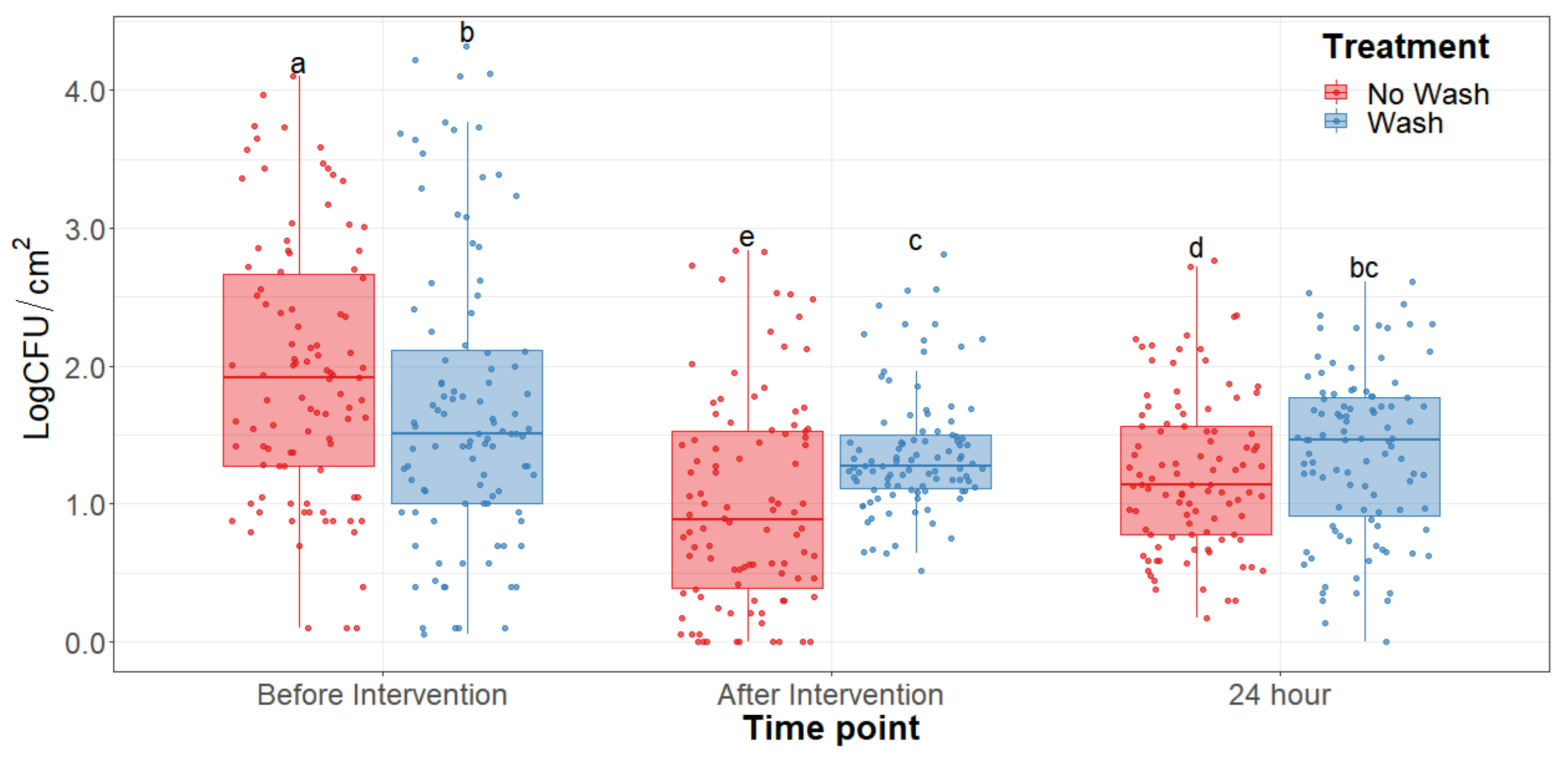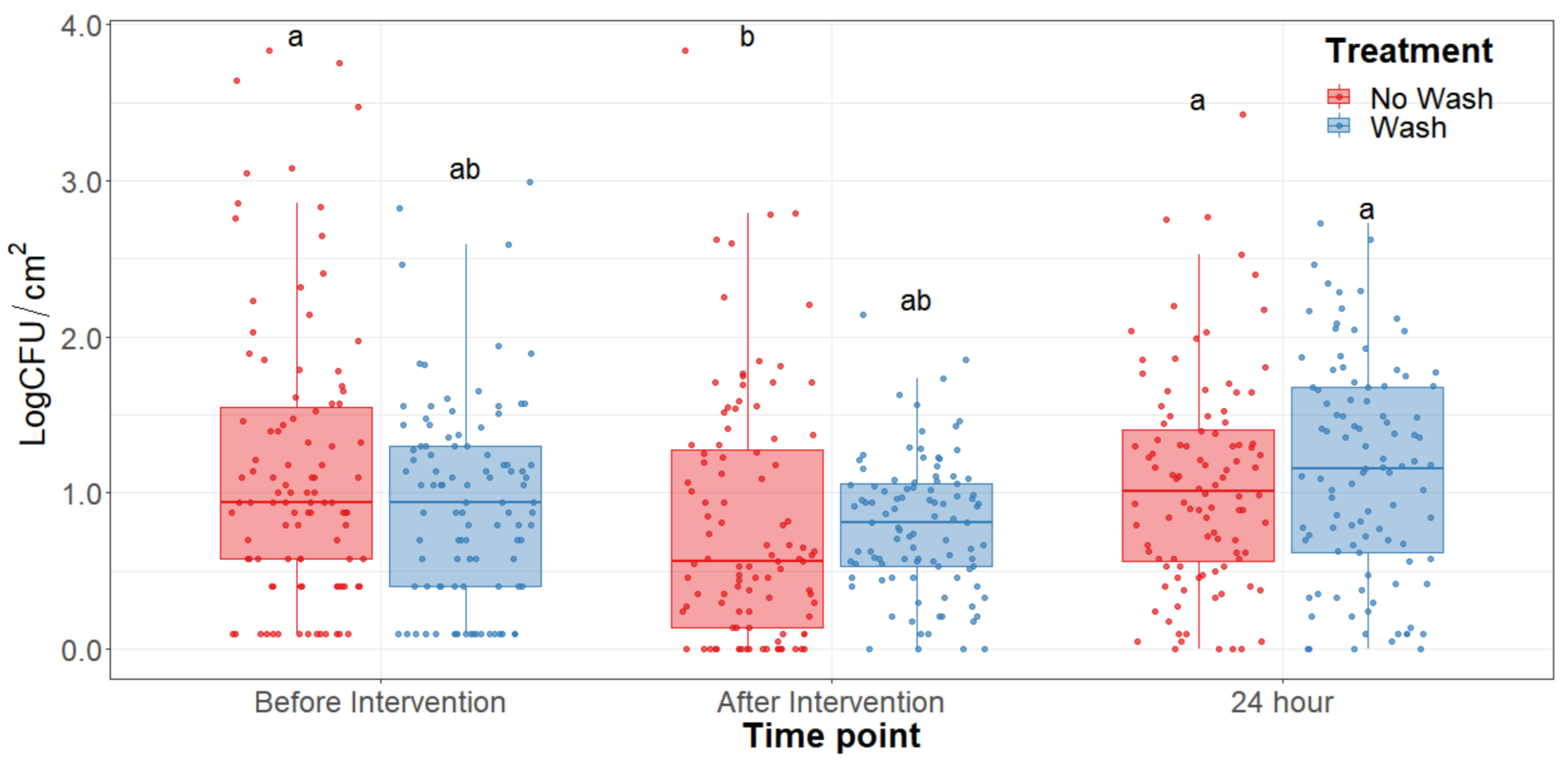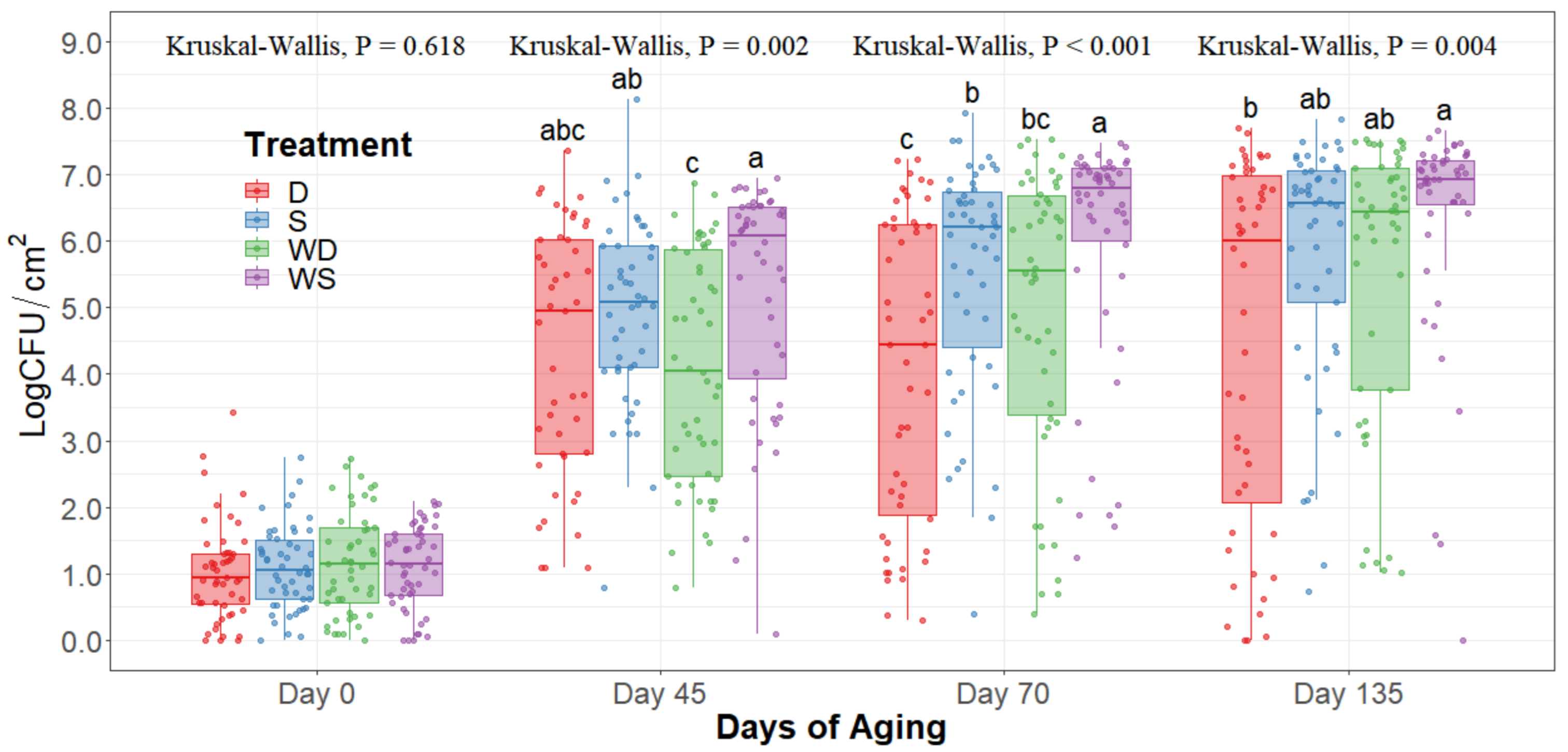Biomapping of Microbial Indicators on Beef Subprimals Subjected to Spray or Dry Chilling over Prolonged Refrigerated Storage
Abstract
1. Introduction
2. Materials and Methods
2.1. Sample Collection
2.2. Sample Processing
2.3. Experimental Design and Statistical Analysis
3. Results
3.1. Hot Water Wash
3.2. Extended Shelf Life of Striploins
4. Discussion
5. Conclusions
Supplementary Materials
Author Contributions
Funding
Institutional Review Board Statement
Informed Consent Statement
Data Availability Statement
Acknowledgments
Conflicts of Interest
References
- Sun, X.D.; Holley, R.A. Antimicrobial and Antioxidative Strategies to Reduce Pathogens and Extend the Shelf Life of Fresh Red Meats. Compr. Rev. Food Sci. Food Saf. 2012, 11, 340–354. [Google Scholar] [CrossRef]
- Zhou, G.H.; Xu, X.L.; Liu, Y. Preservation technologies for fresh meat—A review. Meat Sci. 2010, 86, 119–128. [Google Scholar] [CrossRef] [PubMed]
- Anonymous. ‘Fresh, Never Frozen’ Trend Puts Pressure on the Cold Supply Chain|ProFood World. Available online: https://www.profoodworld.com/processing-equipment/heating-cooling-and-freezing/article/13279984/fresh-never-frozen-trend-puts-pressure-on-the-cold-supply-chain (accessed on 28 October 2020).
- Food Safety Inspection Service Fresh, “Not Frozen” and Similar Terms when Labeling Meat and Poultry Products. Available online: https://www.fsis.usda.gov/wps/portal/fsis/topics/regulatory-compliance/labeling/claims-guidance/fresh-not-frozen-and-similar-terms (accessed on 28 October 2020).
- Daniels, J. Japan Ends Longstanding Trade Restrictions on American Beef: USDA. Available online: https://www.cnbc.com/2019/05/17/japan-ends-longstanding-trade-restrictions-on-american-beef-usda.html (accessed on 28 October 2020).
- Foreign Agriculture Service International Agricultural Trade Report United States Agricultural Exports to Japan Remain Promising. Available online: https://www.fas.usda.gov/data/united-states-agricultural-exports-japan-remain-promising (accessed on 28 October 2020).
- Meat and Livestock Australia Market Snapshot|Beef and Sheepmeat European Union. Available online: https://www.mla.com.au/globalassets/mla-corporate/prices--markets/documents/os-markets/red-meat-market-snapshots/2019/mla-ms-european-union-beef-sheep-2019.pdf (accessed on 28 October 2020).
- Algino, R.J.; Ingham, S.C.; Zhu, J. Survey of antimicrobial effects of beef carcass intervention treatments in very small state-inspected slaughter plants. J. Food Sci. 2007, 72, M173–M179. [Google Scholar] [CrossRef] [PubMed]
- Hur, S.J.; Jin, S.K.; Park, J.H.; Jung, S.W.; Lyu, H.J. Effect of modified atmosphere packaging and vacuum packaging on quality characteristics of low grade beef during cold storage. Asian Australas. J. Anim. Sci. 2013, 26, 1781–1789. [Google Scholar] [CrossRef]
- Castillo, A.; Lucia, L.M.; Goodson, K.J.; Savell, J.W.; Acuff, G.R. Use of hot water for beef carcass decontamination. J. Food Prot. 1998, 61, 19–25. [Google Scholar] [CrossRef]
- Ingham, S.C.; Buege, D.R. 6-Day Dry-Aging as a Beef Slaughter Intervention Treatment. Available online: https://meathaccp.wisc.edu/assets/beef_carcass_dry-aging.pdf (accessed on 2 June 2021).
- Dashdorj, D.; Tripathi, V.K.; Cho, S.; Kim, Y.; Hwang, I. Dry aging of beef; Review. J. Anim. Sci. Technol. 2016, 58. [Google Scholar] [CrossRef]
- Nortje, G.L.; Naude, R.T. Microbiology of Beef Carcass Surfaces. J. Food Protecion 1981, 44, 355–358. [Google Scholar] [CrossRef]
- Bacon, R.T.; Belk, K.E.; Sofos, J.N.; Clayton, R.P.; Reagan, J.O.; Smith, G.C. Microbial populations on animal hides and beef carcasses at different stages of slaughter in plants employing multiple-sequential interventions for decontamination. J. Food Prot. 2000, 63, 1080–1086. [Google Scholar] [CrossRef]
- McEvoy, J.M.; Sheridan, J.J.; Blair, I.S.; McDowell, D.A. Microbial contamination on beef in relation to hygiene assessment based on criteria used in EU Decision 2001/471/EC. Int. J. Food Microbiol. 2004, 92, 217–225. [Google Scholar] [CrossRef]
- Chang, V.P.; Mills, E.W.; Cutter, C.N. Reduction of bacteria on pork carcasses associated with chilling method. J. Food Prot. 2003, 66, 1019–1024. [Google Scholar] [CrossRef]
- Kinsella, K.J.; Sheridan, J.J.; Rowe, T.A.; Butler, F.; Delgado, A.; Quispe-Ramirez, A.; Blair, I.S.; McDowell, D.A. Impact of a novel spray-chilling system on surface microflora, water activity and weight loss during beef carcass chilling. Food Microbiol. 2006, 23, 483–490. [Google Scholar] [CrossRef]
- Vargas, D.A.; Miller, M.F.; Woerner, D.R.; Echeverry, A. Microbial Growth Study on Pork Loins as Influenced by the Application of Different Antimicrobials. Foods 2021, 10, 968. [Google Scholar] [CrossRef]
- Jay, J.M. A Review of Aerobic and Psychrotrophic Plate Count Procedures for Fresh Meat and Poultry Products. J. Food Prot. 2002, 65, 1200–1206. [Google Scholar] [CrossRef]
- Conover, W.J. Practical Nonparametric Statistics; Wiley Series: Hoboken, NJ, USA, 1998; ISBN 9780471160687. [Google Scholar]
- Castillo, A.; Lucia, L.M.; Goodson, K.J.; Savell, J.W.; Acuff, G.R. Comparison of Water Wash, Trimming, and Combined Hot Water and Lactic Acid Treatments for Reducing Bacteria of Fecal Origin on Beef Carcasses. J. Food Prot. 1998, 61, 823–828. [Google Scholar] [CrossRef]
- Fletcher, B.; Mullane, K.; Platts, P.; Todd, E.; Power, A.; Roberts, J.; Chapman, J.; Cozzolino, D.; Chandra, S. Advances in meat spoilage detection: A short focus on rapid methods and technologies. CYTA J. Food 2018, 16, 1037–1044. [Google Scholar] [CrossRef]
- Hardin, M.D.; Acuff, G.R.; Lucia, L.M.; Oman, J.S.; Savell, J.W. Comparison of Methods for Decontamination from Beef Carcass Surfaces. J. Food Prot. 1995, 58, 368–374. [Google Scholar] [CrossRef] [PubMed]
- Phebus, R.K.; Nutsch, A.L.; Schafer, D.E.; Wilson, J.R.C.; Riemann, M.J.; Leising, J.D.; Kastner, C.L.; Wolf, J.R.; Prasap, R.K. Comparison of Steam Pasteurization and Other Methods for Reduction of Pathogens on Surfaces of Freshly Slaughtered Beef. J. Food Prot. 1997, 60, 476–484. [Google Scholar] [CrossRef]
- Goepfert, J.M. The Aerobic Plate Count, Coliform and Escherichia coli Content of Raw Ground Beef at the Retail Level. J. Milk Food Technol. 1976, 39, 175–178. [Google Scholar] [CrossRef]
- Dormedy, E.S.; Brashears, M.M.; Cutter, C.N.; Burson, D.E. Validation of acid washes as critical control points in hazard analysis and critical control point systems. J. Food Prot. 2000, 63, 1676–1680. [Google Scholar] [CrossRef]
- Sumner, J.; Vanderlinde, P.; Kaur, M.; Jenson, I. The Changing Shelf Life of Chilled, Vacuum-Packed Red Meat. In Food Safety and Quality-Based Shelf Life of Perishable Foods; Springer International Publishing: Berlin, Germany, 2021; pp. 145–156. [Google Scholar]
- Ghafir, Y.; China, B.; Dierick, K.; De Zutter, L.; Daube, G. Hygiene indicator microorganisms for selected pathogens on beef, pork, and poultry meats in Belgium. J. Food Prot. 2008, 71, 35–45. [Google Scholar] [CrossRef] [PubMed]
- Buege, D.; Ingham, S. Small Plant Intervention Treatments to Reduce Bacteria on Beef Carcasses at Slaughter. Available online: https://meathaccp.wisc.edu/validation/assets/SmallPlantAntimicrobialIntervention.pdf (accessed on 10 June 2020).
- Calicioglu, M.; Kaspar, C.W.; Buege, D.R.; Luchansky, J.B. Effectiveness of spraying with tween 20 and lactic acid in decontaminating inoculated Escherichia coli O157:H7 and indigenous Escherichia coli biotype I on beef. J. Food Prot. 2002, 65, 26–32. [Google Scholar] [CrossRef]
- Food Safety and Inspection Service Sampling Requirements to Demonstrate Process Control in Slaughter Operations. Available online: https://www.fsis.usda.gov/wps/portal/fsis/topics/regulatory (accessed on 4 January 2021).
- Casas, D.E.; Vargas, D.A.; Randazzo, E.; Lynn, D.; Echeverry, A.; Brashears, M.M.; Sanchez-Plata, M.X.; Miller, M.F. In-Plant Validation of Novel On-Site Ozone Generation Technology (Bio-Safe) Compared to Lactic Acid Beef Carcasses and Trim Using Natural Microbiota and Salmonella and E. coli O157:H7 Surrogate Enumeration. Foods 2021, 10, 1002. [Google Scholar] [CrossRef]
- Campañone, L.A.; Roche, L.A.; Salvadori, V.O.; Mascheroni, R.H. Monitoring of Weight Losses in Meat Products during Freezing and Frozen Storage. Food Sci. Technol. Int. 2002, 8, 229–238. [Google Scholar] [CrossRef]
- Zhang, Y.; Mao, Y.; Li, K.; Luo, X.; Hopkins, D.L. Effect of Carcass Chilling on the Palatability Traits and Safety of Fresh Red Meat. Compr. Rev. Food Sci. Food Saf. 2019, 18, 1676–1704. [Google Scholar] [CrossRef]





| Microorganism | Treatment | Timepoint (LogCFU/cm2 ± S.E. 1) | |||||
|---|---|---|---|---|---|---|---|
| Before Wash | After Wash | Day 0 | Day 45 | Day 70 | Day 135 | ||
| Aerobic plate count | No wash Dry | 1.96 ± 0.10 | 1.01 ± 0.04 | 1.23 ± 0.08 | 3.62 ± 0.29 | 3.19 ± 0.36 | 3.97 ± 0.38 |
| No wash Spray | 1.23 ± 0.08 | 4.33 ± 0.20 | 5.1 ± 0.28 | 5.39 ± 0.31 | |||
| Wash Dry | 1.72 ± 0.09 | 1.38 ± 0.08 | 1.31 ± 0.09 | 3.55 ± 0.25 | 4.51 ± 0.32 | 5.05 ± 0.35 | |
| Wash Spray | 1.42 ± 0.08 | 4.67 ± 0.24 | 5.41 ± 0.24 | 6.11 ± 0.24 | |||
| Psychrotroph count | No wash Dry | 1.16 ± 0.06 | 0.80 ± 0.04 | 1.02 ± 0.10 | 4.37 ± 0.27 | 4.09 ± 0.33 | 4.55 ± 0.38 |
| No wash Spray | 1.10 ± 0.09 | 4.97 ± 0.20 | 5.54 ± 0.25 | 5.80 ± 0.26 | |||
| Wash Dry | 0.93 ± 0.09 | 0.80 ± 0.08 | 1.17 ± 0.11 | 4.11 ± 0.24 | 4.96 ± 0.20 | 5.52 ± 0.30 | |
| Wash Spray | 1.11 ± 0.09 | 5.22 ± 0.24 | 6.00 ± 0.25 | 6.34 ± 0.23 | |||
| Enterobacteriaceae count | No wash Dry | 0.19 ± 0.05 | 0.04 ± 0.02 | 0.00 * | 0.4 ± 0.12 | 1.23 ± 0.28 | 1.81 ± 0.38 |
| No wash Spray | 0.01 ± 0.01 | 1.44 ± 0.22 | 2.18 ± 0.29 | 2.42 ± 0.35 | |||
| Wash Dry | 0.02 ± 0.01 | 0.00 * | 0.00 * | 0.94 ± 0.20 | 1.39 ± 0.27 | 1.99 ± 0.35 | |
| Wash Spray | 0.00 * | 1.71 ± 0.24 | 2.78 ± 0.33 | 3.28 ± 0.38 | |||
| Coliform count | No wash Dry | 0.02 ± 0.01 | 0.02 ± 0.01 | 0.12 ± 0.06 | 0.12 ± 0.08 | 0.22 ± 0.13 | 0.51 ± 0.24 |
| No wash Spray | 0.19 ± 0.07 | 0.47 ± 0.07 | 0.47 ± 0.16 | 0.69 ± 0.25 | |||
| Wash Dry | 0.00 * | 0.00 * | 0.04 ± 0.04 | 0.04 ± 0.04 | 0.24 ± 0.16 | 0.53 ± 0.23 | |
| Wash Spray | 0.17 ± 0.07 | 0.35 ± 0.07 | 0.66 ± 0.24 | 0.90 ± 0.29 | |||
Publisher’s Note: MDPI stays neutral with regard to jurisdictional claims in published maps and institutional affiliations. |
© 2021 by the authors. Licensee MDPI, Basel, Switzerland. This article is an open access article distributed under the terms and conditions of the Creative Commons Attribution (CC BY) license (https://creativecommons.org/licenses/by/4.0/).
Share and Cite
Casas, D.E.; Manishimwe, R.; Forgey, S.J.; Hanlon, K.E.; Miller, M.F.; Brashears, M.M.; Sanchez-Plata, M.X. Biomapping of Microbial Indicators on Beef Subprimals Subjected to Spray or Dry Chilling over Prolonged Refrigerated Storage. Foods 2021, 10, 1403. https://doi.org/10.3390/foods10061403
Casas DE, Manishimwe R, Forgey SJ, Hanlon KE, Miller MF, Brashears MM, Sanchez-Plata MX. Biomapping of Microbial Indicators on Beef Subprimals Subjected to Spray or Dry Chilling over Prolonged Refrigerated Storage. Foods. 2021; 10(6):1403. https://doi.org/10.3390/foods10061403
Chicago/Turabian StyleCasas, Diego E., Rosine Manishimwe, Savannah J. Forgey, Keelyn E. Hanlon, Markus F. Miller, Mindy M. Brashears, and Marcos X. Sanchez-Plata. 2021. "Biomapping of Microbial Indicators on Beef Subprimals Subjected to Spray or Dry Chilling over Prolonged Refrigerated Storage" Foods 10, no. 6: 1403. https://doi.org/10.3390/foods10061403
APA StyleCasas, D. E., Manishimwe, R., Forgey, S. J., Hanlon, K. E., Miller, M. F., Brashears, M. M., & Sanchez-Plata, M. X. (2021). Biomapping of Microbial Indicators on Beef Subprimals Subjected to Spray or Dry Chilling over Prolonged Refrigerated Storage. Foods, 10(6), 1403. https://doi.org/10.3390/foods10061403






